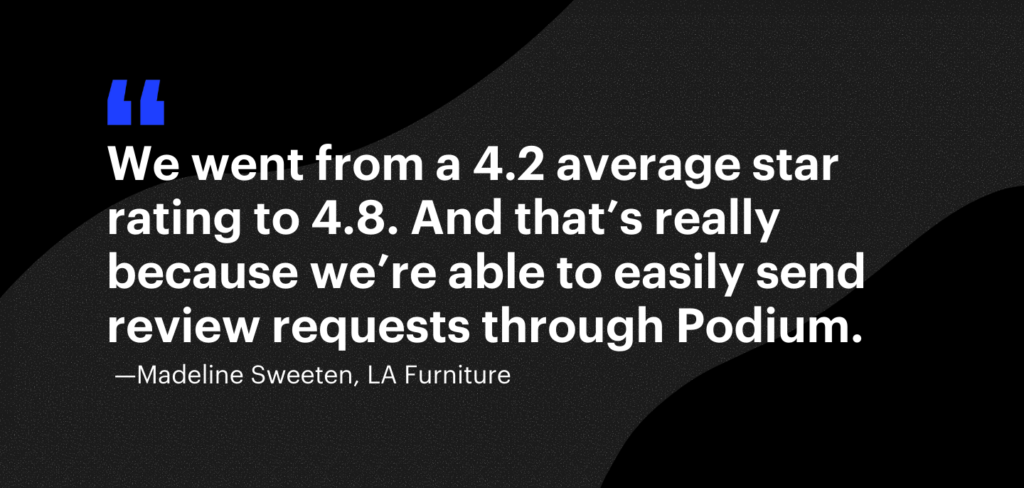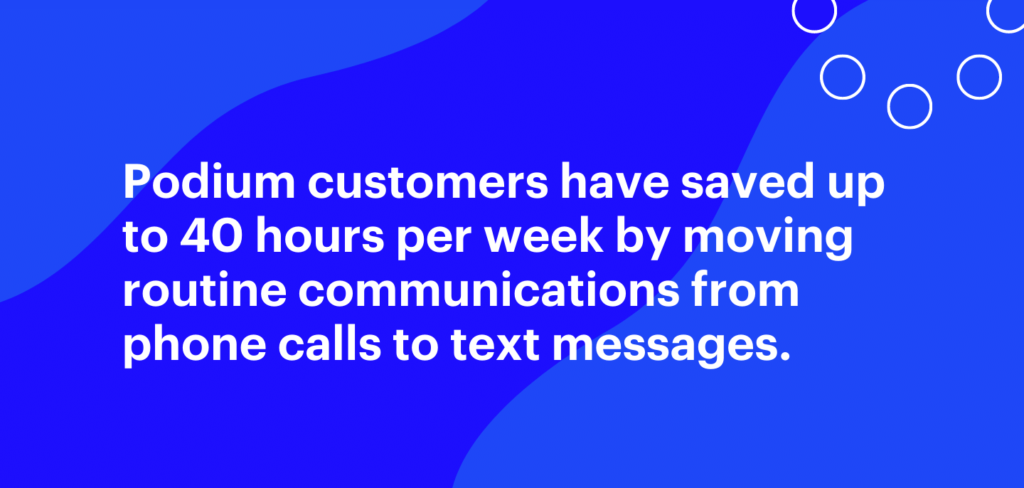In a recent Podium survey, 9 out of 10 consumers stated they would go out of their way to solicit local businesses in their community. After the uncertainty of the last two years, this is a welcome change for businesses that depend on a local customer base. The question is, how can local businesses make the most of this opportunity?
Like all opportunities, the rise in popularity of local options comes with some challenges. The competition for local business owners is fiercer than ever before, so if your marketing plan isn’t in top shape, you’re going to struggle to win customers. At Podium, we partner with over 100,000 local businesses, and we see similar marketing challenges across all industries and geographies. In this article, we’ll outline some of the top marketing challenges we hear about from our small business customers and share actionable tips to help you address those challenges and meet your marketing goals.
3 Marketing Challenges Every Local Business Faces and How to Fix Them
Challenge 1: Lead Generation and Finding New Customers
Every small business knows that finding new customers requires consistent effort. Today, the vast majority of customer acquisition happens online. In fact, over 60% of customers start their shopping journey online. This means a standout online presence is the first crucial step in generating more leads.
But, how can you build a strong online presence that consistently brings in new customers? Here are a few key elements:
→ A detailed Google Business Profile. Your Google Business Profile is often a prospect’s first impression of your business—before they even visit your website—and when used effectively, it can be an excellent lead generation tool. Ensure your Google Business Profile is up-to-date with the latest information about your business, such as contact information, address, hours of operation, and great photos that highlight your products and services. This will make it easy for web visitors to call, message, visit your website, or get directions to your business.
→ A compelling website. After your Google Business Profile, your website is often your next big opportunity to capture leads online. If you are struggling to generate leads from your website, talk to your customers about what would make it better. Look to create a website that makes it easy for customers to learn about your services and start conversations with you. Interactive tools like webchat can be game-changers when it comes to turning your website into a lead-generating machine.
→ An active social media presence. Social media has become one of the fastest ways for local businesses to get in front of potential customers online. Consumers often use social media sites to contact businesses with questions. To ensure you’re not left out of the conversation, make sure you have active social media accounts on Facebook and Instagram, and respond quickly to questions on those platforms. To save time and simplify your customer communications, consider adopting a communication tool that consolidates your conversations from all platforms into one place.
→ A strong online reputation. Your Google Business Profile also contains a summary of your Google Reviews—one of the strongest marketing tools at your disposal. Google displays highly-rated businesses at the top of search results. Consider leveraging a reputation management tool to make it easy to regularly collect reviews from your happy customers and increase your Google rating.

Once these basic elements are in place, you can turn your attention to digital marketing to capture even more leads.
Challenge 2: Retaining Customers
One of the easiest ways to increase revenue is to increase repeat purchases from existing customers. New customer acquisition costs, on average, are five times more than customer retention. Existing customers are also 60-70% more likely to buy from you than new customers, seven times more likely to purchase a new product, and four times more likely to refer a friend to your business. This means that if a customer has purchased from you once, convincing them to come back should be a top priority.
The most effective ways to improve customer retention are to provide an unbeatable customer experience and connect with customers via marketing campaigns made just for them. Here are the best practices we see from our local business customers:
→ Create a winning customer experience. Customer experience is the fundamental driver of loyalty. Customers crave a delightful experience, and they are willing to spend more when they find it. This is why businesses should prioritize designing and delivering an exceptional customer experience. Customer experience includes every touchpoint a customer has with your business. Things like marketing and advertising, your online presence, how the customer discovers you, their interaction with your business, and their experience after the sale are all pieces in the customer experience puzzle. It’s a lot, but you don’t have to transform every customer interaction overnight. For starters, focus on increasing convenience and simplicity at every step of your customer journey. Next, dive deeper by making plans to measure and improve your customer experience.
→ Market often to past customers. Past customers, just like leads or prospects, need to be reminded that your business is open and ready to serve their needs. Consider creating special promotions or marketing events specifically for past customers. Be willing to use a more familiar channel–like text–with prospective customers, who already know and trust your business. Text message marketing will help you see open rates and click rates that far surpass the results from email marketing. Learn more about customer marketing with text messages with our handy YouTube series.
Challenge 3: Lack of Time and Resources for Marketing
Small business owners already wear a thousand hats; finding time and resources for marketing can be the biggest challenge of all. Whether you have a marketing department or you’re juggling marketing responsibilities among several teams, here are a few tips to save time and make marketing less burdensome for your team:
→ Look for opportunities to automate. Every business uses software tools—sometimes dozens of them—and a common software feature is the ability to schedule or automate routine tasks. Your marketing platform, CRM, or point of sale software should help you save time by automating marketing tasks such as emails and texts, contact status changes, or review invitations. While each tool plays an individual role in your marketing efforts, multiple automation tools can often be integrated to create a seamless workflow. If your software tools do not allow for integration or automation, consider looking for systems that do.
→ Try a new communication method. While phone calls are still the most common way for leads to contact your business, other communication channels such as text messaging might be more convenient for your business and your customers. Many modern communication providers can enable your existing business phone number to send and receive texts–saving you valuable time on the phone. To start modernizing communication at your business, choose a business texting provider and advertise your phone line as “textable.” Our customers have saved up to 40 hours per week by moving routine communications from phone calls to text messages.

With more customers than ever before favoring local options, small business owners have a unique opportunity to connect with new people and grow their business. This opportunity doesn’t come without challenges, though, and if business owners want to stay ahead of the competition, taking control of their marketing is essential. With a focus on online presence, some tweaks to existing marketing processes, and the help of tools like Podium, your business is sure to come out on top.




